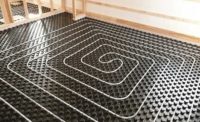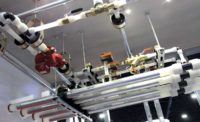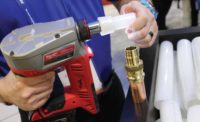Demand for hydronic comfort solutions is heating up. According to a report by Technavio, the global market is expected to increase by more than 7 percent from 2018 to 2022, driven by a desire for more energy-efficient and energy-neutral technologies to improve the indoor climate.
“In residential applications, the growing demand for smart and healthier homes aligns perfectly with radiant floor heating applications,” said Devin Abellon, business development manager – engineering services at Uponor.
Generally speaking, most people in the industry believe the uses of hydronic systems are increasing … probably at a 5 to 10 percent per year rate, according to Les Nelson, vice president of the Radiant Professionals Alliance.
“If you’re in the HVAC business at all, and [hydronic or radiant] systems are going in in your neighborhood, it’s important to recognize that it’s a profitable market, and it’s competitive,” Nelson said. “So the sooner you get involved, the better.”
HIGH DOLLARS AT THE HIGH END
With more homeowners and building owners looking to advance the technologies in their structures to make them smarter, more efficient, or just more comfortable, it’s in a contractor’s best interest to become proficient in radiant heating and cooling systems to further expand their market — or, to dominate a niche market.
A hydronic radiant system works well with energy-neutral heating and cooling sources, such as geothermal, Abellon explained. And since water has the capacity to transport energy 3,500 times greater than air, it makes for a highly efficient system.
“Smart homes and smart buildings are seeing the trend of radiant increase, as awareness grows in the building industry of all the benefits radiant provides — not just in terms of energy efficiency, but also indoor environmental quality (IEQ),” Abellon said. “As the heating and cooling landscape evolves to newer technologies, becoming proficient in radiant design and installation will give a contractor the edge over the competition.”
Because radiant is still a niche specialty, contractors who forge their reputations as quality radiant installers will gain market share with both new customers, who are looking to add the comfort and efficiency of radiant to their spaces, and existing radiant users seeking service work. It’s a smaller market, but the customers are diehards.
“The main thing is less competition,” said Vince Youndt, president, Vertex Heating, Cooling, Geothermal. “When you get really good at it and can attach a reputation to it, you can see very healthy margins. There is also a ton of flexibility on what you can offer in hydronics. Anything from simple water coils or baseboard, all the way up to full-blown radiant.”
Certainly, residential applications are popular — mostly with people who already owned a home with radiant heat and are building another home, according to Nelson.
“Once you’ve lived in a radiant-heated house, you really don’t want to turn back to other type of heating,” he said.
There’s no air blowing around, for the most part. The heat radiates from the floor or the walls and ceiling, traveling from warm bodies to cold bodies, and can travel just as easily up or down.
“It’s very, very comfortable; people swear by it, basically,” Nelson said. “That is the primary reason people want to install it.”
Typically, it’s for a new house they are building.
“I’m not familiar with very many subdivision-type installations where each home has it. I’m sure they are out there, but it’s typically higher-end homes,” Nelson said.
Hence, projects in this market also tend to be higher-income or higher-dollar jobs.
“The systems aren’t inexpensive, but they can be very, very efficient,” Nelson said. “That does come at a dollar cost. It’s a product that you can typically offer at a price that can be very profitable.”
Think one-and-a-half to three times the cost over a conventional-type system.
GETTING STARTED
Education is imperative for contractors who want to get into the radiant space, said Abellon. Radiant pipe manufacturers offer factory training to learn about important factors in a radiant design, such as heat loss calculations, zoning, and pump sizing.
“The key to remember is that educating and training must come first,” Abellon said. “Learning good design practices and layout techniques will set contractors on a course for success in a field that’s only going to grow in the future.”
“It’s not like where you put in ductwork and a furnace, and you’re done with it — there’s more of a design aspect than with commonplace heating and cooling systems,” said Nelson.
Many companies typically involved in radiant have plumbing backgrounds as well as HVAC backgrounds.
“Hydronics is just moving heat … around the building via water versus air — or, increasingly, via VRF equipment, which uses refrigerant to move it around the building,” Nelson added. “But the most efficient way is water. For companies that are involved in custom home construction, adding this capability really enables them to offer something that relatively well-off clients, in many cases, would like to hear about and use.”
Once trained, residential contractors should start small, Youndt advised.
“You want to get a feel for how to bid the labor,” he said. “There are some tricks that can make it go much faster, but if you don’t learn those on a small-scale job, you could really get yourself in trouble on a large-scale job.”
For example, a contractor might start with projects like a kitchen or master bathroom, then move on to larger spaces like unfinished basements before tackling a whole-home radiant project, Abellon advised.
“For existing structures, radiant is ideal in unfinished basements to transform cold, concrete floors into warm, comfortable spaces for year-round useable square footage in a home,” he said. “In commercial applications, radiant heating and cooling works very well in large, open spaces, such as retail and warehouses or expansive atriums with high ceilings and floor-to-ceiling glass windows.”
Converting an existing building to radiant heat or radiant cooling is not a huge part of the marketplace, Nelson said, as quite a bit of the installation requires tearing up the building.
“It’s done, but not as frequently as new construction, which is the majority of the marketplace.”
In addition, large-scale commercial construction or new residential construction usually involves an architect or a design firm, which takes that burden off the contractor. Commercial contractors would do best to start off with smaller projects like a lobby space, Abellon said.
“Moving toward more challenging projects, such as 100,000-square-foot buildings or large glass atriums, are best tackled after a few successful radiant projects are completed,” he said.
MATS, MOLDING, AND MANIFOLDS
For residential applications, manufacturers offer several products that can make installations faster and easier.
“There are pre-formed knobbed mats, such as Fast Trak, as well as plywood radiant panels, such as Quik Trak — both from Uponor — that are ideal for existing residential spaces due to the low profile of the product, eliminating the need to alter baseboards, moldings, and doors,” said Abellon.
1, 2, 3: Products like Quik Trak and Fast Trak, both by Uponor, help speed up the installation project. “You lay that product out on the floor, you insert the tubing into these knobs, add the Quick Crete on top of that … it saves a great deal of time,” said Les Nelson, vice president of the Radiant Professionals Alliance.
Installation is merely fastening the panels to the floor and snapping the flexible radiant tubing into a channel.
“You lay that product out on the floor, you insert the tubing into these knobs, add the Quick Crete on top of that … it saves a great deal of time,” Nelson said.
For commercial applications, custom-designed radiant tubing mats that “roll out” into the space can save time with setup; Uponor said the Radiant Rollout Mat saves upwards of 80 percent in certain instances.
Other products that have made systems easier to use and to install include plumbing manifold products and wireless thermostats
“Your heat source, typically a boiler, is generating heated water that is distributed to the various zones in the building,” Nelson explained. “Each zone would be one station in a manifold, which might have five to 10 total stations. Manufacturers, again, have been continuously improving [these products] over time; they’re just designed to make the system easier to install.”
Publication date: 2/11/2019
Want more HVAC industry news and information? Join The NEWS on Facebook, Twitter, and LinkedIn today!










